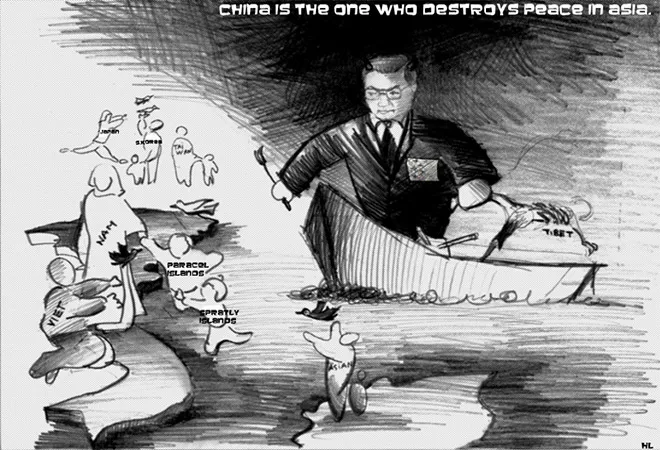
The National Intelligence Council (NIC) of the United States released its Global Trends report last month. Titled Paradox of Progress, it warns its readers to buckle themselves for an increasingly turbulent future. Much of this turbulence, it argues, would emanate from a phenomenon the world has not seen in at least since the end of the Cold War: hegemonic struggles among major powers. The decline of American power, according to the NIC, is one of the main reasons for such grim prognostication. But so is the possibility of China replacing the US hegemony. In short, the report appears to confirm an already existing impression: that the global liberal order, largely a product of post-Second World War US power, may be short-lived. The most likely casualty of this power shift would be the US hegemony in the Indo-Pacific.
The decline of the US power is arguably manifesting itself in the current inward trend in US foreign policy. The US now intends to tamper down on its commitments to its allies in the Asia-Pacific and is actively encouraging them to bear most of the burden of their alliance commitments. Rather than an active balancer of Chinese power in the Indo-Pacific, the US appears to be moving to a posture of off-shore balancing. Neo-isolationist tendencies in American body politic may further entrench China’s hegemonic role in the region, analysts fear.
Despite a grim perception of a decline in the US power in Asia and China’s rise, it is not readily evident that the regional order in the Indo-Pacific will witness a Chinese hegemony. To achieve regional hegemony, three conditions are necessary. First, a regional hegemon has to effectively control not only the continental sphere of influence but also the maritime domain. Second, regional hegemony requires all possible rivals to be neutralised. Lastly, hegemony must exude a benign character since the difference between hegemony and raw power is one of legitimacy. China falls short in all these categories.
Read Also | India needs to find other ways to deal with China
China by its nature has always been a continental power. It is hemmed in by land frontiers from three directions. Some of these are disputed, for example the India-China border. In Central Asia, its intentions to expand its sphere of influence contests with those of Russia. Even when China has pacified most of its territorial disputes, the contestations on the continental front are still active. Moreover, China’s growing dominance in the continental sphere notwithstanding, its maritime frontiers remain far from stable. . China’s maritime presence is restricted by geography itself. Its access to the Pacific Ocean is blocked by a ring of hostile Island Chains. The presence of states such as Taiwan, Philippines, and Japan are natural obstacles to China’s maritime influence. Its access to the Indian Ocean is similarly imperilled by the tyranny of geography especially its Malacca dilemma. However, the real problem for China is the presence of the US Navy and its unparalleled control over Asia-Pacific’s maritime domain. China’s sea denial capabilities in the form of a substantive submarine fleet and anti-access missiles are largely defensive systems which add little to its ability to project power. As David Shambaugh argues, “Chinese military forces still possess no conventional global power-projection capabilities.” Projection of power demands sea control capabilities: a large fleet of aircraft carriers. With its first aircraft carrier still under development, that is a prospect which will require substantial effort and time. It will also lead to employment of asymmetric warfare against its own sea control assets, as is currently the Chinese strategy towards the US Navy. And even when US may decide to gradually move out of the Indo-Pacific, a remote possibility indeed, China will have to contend other equally capable navies especially with Japan in East Asia and India in the Indian Ocean. China’s prospects of dominating the Asia-Pacific’s maritime domain are therefore bleak. And if the history of great power rivalries has anything to offer for contemporary analysis, no continental power can be a regional hegemon without establishing an absolute control over the maritime domain. That Beijing realises its maritime vulnerability is evident in China’s frantic attempts to get access to the Indian Ocean through land corridors and naval bases, success of which many argue is doomed to failure.
Second, continental powers generate much more friction than maritime powers do. As Edward Luttwak explains in the Logic of Strategy, the rise of Chinese power will automatically generate countervailing balances. Unlike maritime powers which tend to control the oceans and have limited capacity to pursue territorial aggression, continental powers are perceived to be more hostile due to their capability to pursue territorial harm. Balances of power are more frequently achieved against continental powers as against maritime powers. The case of Germany in both First and Second World War is a case in point. But so was the case of the Soviet Union during the Cold War. China’s maritime disputes with most of its neighbours add to this explosive mix. When seen holistically, China’s rise in the region has led to an increase in balancing activity by other states in the region whether big or small. From India to Japan and Vietnam, the region is witnessing a rise in both internal balancing (increasing military expenditures) but also external balancing. The latter is particularly relevant in the strategic interactions between India, Japan, Australia, Singapore, Vietnam and the US. In the Indo-Pacific, China is increasingly been seen as a hostile power, one that might also remain “lonely”.
If China cannot possibly overcome its continental character to transform into a dominant maritime power and its rise would continue to generate more friction with other states, it’s most difficult internal challenge would be to provide a veneer of legitimacy to its growing power. The US hegemony led to the creation of a liberal global order which benefited most states to some extent. The rise of China in the last quarter of a century could not have been possible without the US-led liberal order. Even if the US hegemony was contested in certain quarters, it was also widely accepted because the US could externalise the benefits of its hegemony to other stakeholders, be it through commerce, institutions, rules and norms. China’s message of harmonious development and peaceful rise was a similar attempt to make its rise more acceptable to the broader Indo-Pacific. But China’s behaviour in recent years has, rather than creating additional legitimacy for itself, made other states more anxious. China’s insulated domestic politics is one reason for this anxiety. Unlike democratic powers, lack of transparency in China’s internal politics creates uncertainty about its intentions. This is most obvious in the debate over China’s military spending. China’s one-party rule does not allow any kind of external influence on its domestic policy. It has been suggested by some that the US hegemony was benign particularly because its domestic politics was always influenced by interest-groups representing many ethnicities and nationalities. In China, such external influences are not possible. Finally, if China was to be the regional growth-engine, recent trends suggest that China may not be able to externalise even the economic benefits in the region. The process of de-globalisation will force China to adopt similar neo-mercantilist economic policies. It has already started transforming its export-oriented economy into one which is sustained by internal consumption. For many of Asia’s smaller economies, penetrating Chinese markets therefore would be an increasingly burdensome exercise.
Notwithstanding NIC’s emphasis on the emerging disorder in the region and beyond, Chinese hegemony in the Indo-Pacific appears to be some way off. One may not dispute the decline in American power and more so its willingness to engage in the region, but to suggest that China will automatically replace United States as the regional hegemon is far-fetched. The current strategic flux surely does make the region and the globe more chaotic but it also offers opportunities to other rising powers like India. For one, it provides India greater strategic space which if used judiciously may help in extracting concessions from the Chinese. If history is any guide to Chinese behaviour, the alignment of international politics has always been a major determinant of Chinese behaviour vis-a-vis New Delhi. For example, after the Sino-Soviet clashes of March 1969, India and China began their first dialogue after the 1962 war. By using China’s sensitivity over its perceived vulnerability in a hegemonic contest with the US, India may profit from this strategic flux. It will also allow her to increase its position in the Indo-Pacific’s new regional order and to create substantive partnerships with countries like Japan and South Korea which New Delhi needs for its own economic development. Finally, any rising power like India needs regional followers. As China’s power increases and perceptions of American decline get further entrenched in the region, India’s efforts to mediate and stand for a liberal regional order may increase its influence especially with the Association of South-East Asian Nations (ASEAN) countries. Increasing uncertainty, as the NIC report suggests, brings disorder but such situations also raise the value of key swing states like India. For rising powers, some disorder is also a virtue.
The views expressed above belong to the author(s). ORF research and analyses now available on Telegram! Click here to access our curated content — blogs, longforms and interviews.




 PREV
PREV



